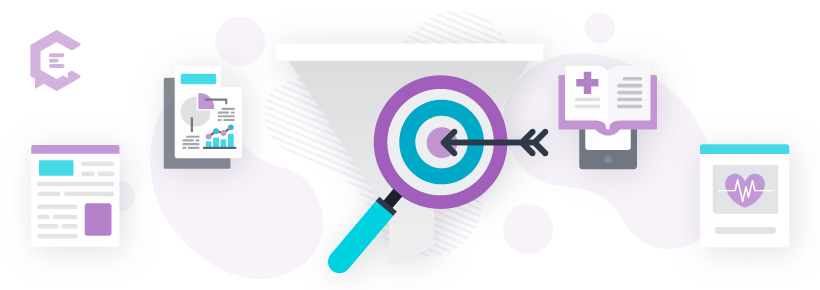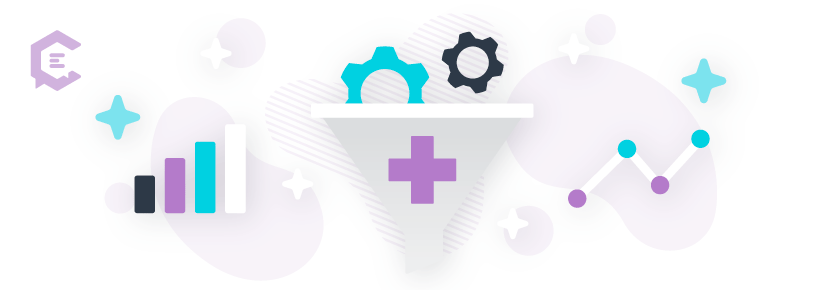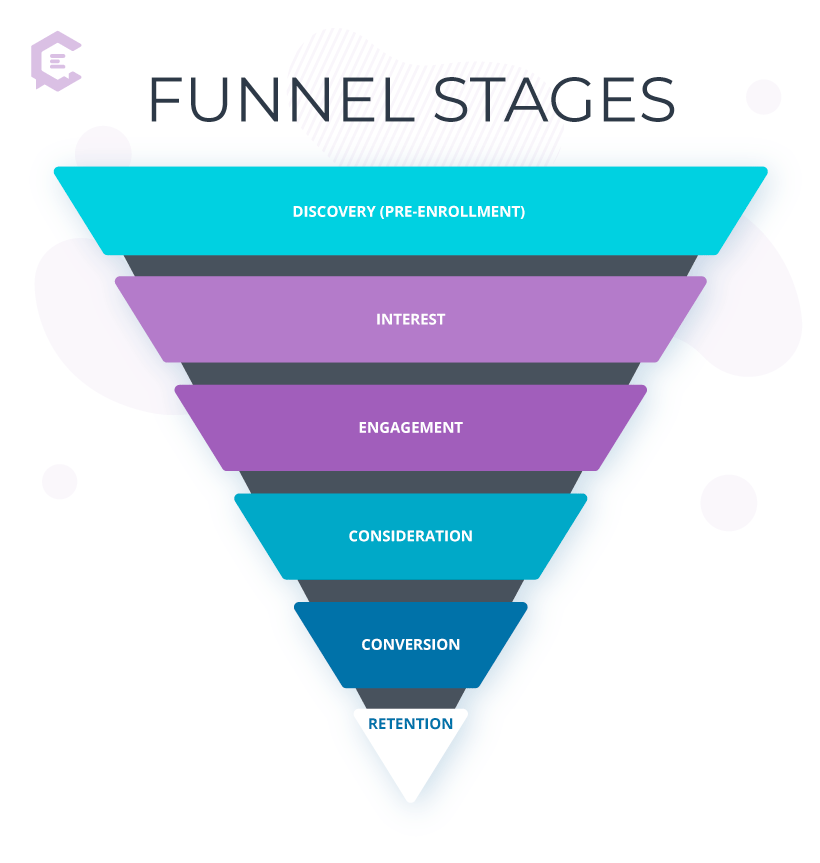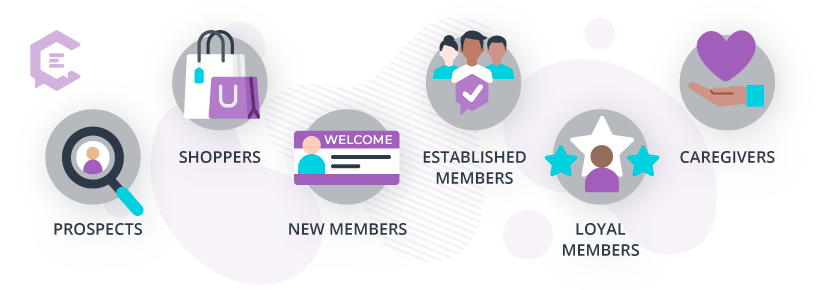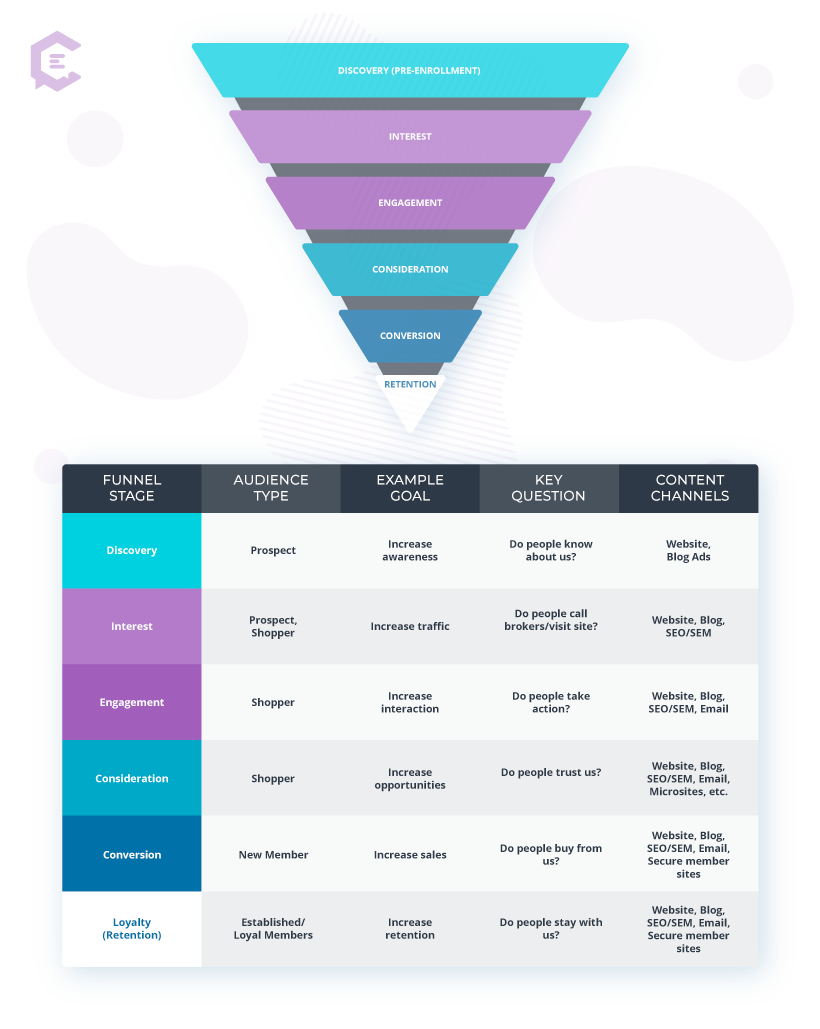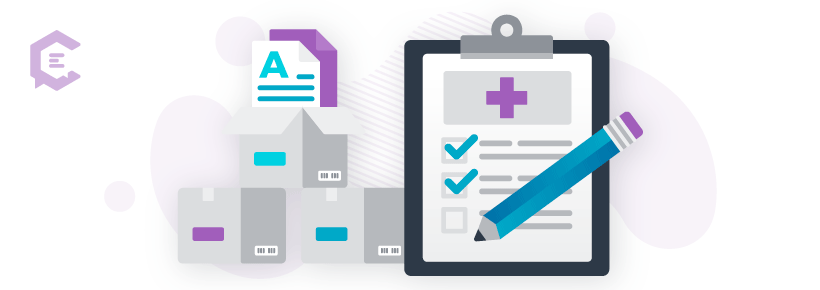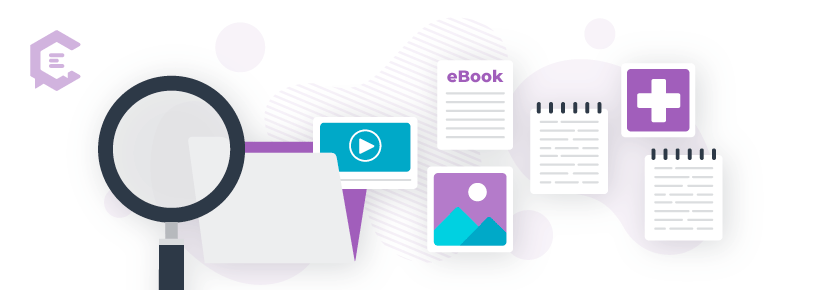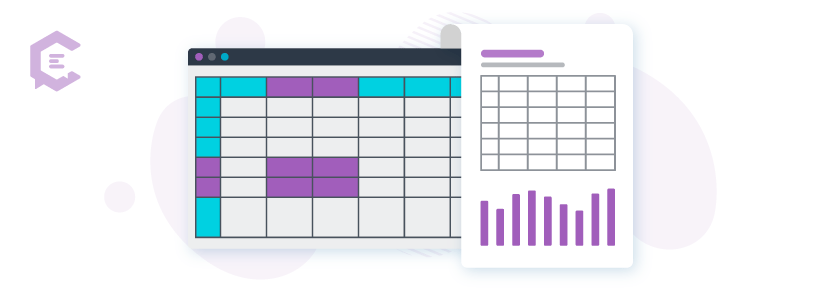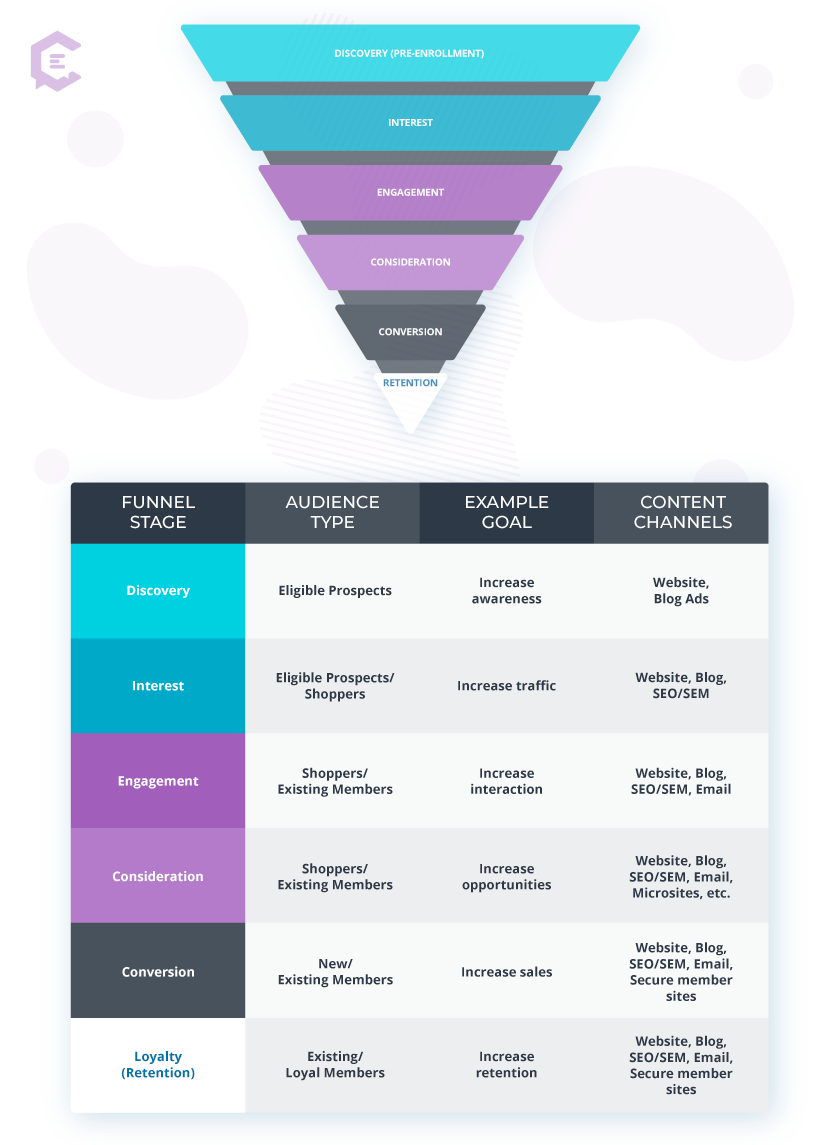Healthcare marketing funnels can be used to map out a happy path for every segment of your audience, helping to guide them on their journey to find health care information that is both relevant and useful.
Let’s start off by agreeing that of the myriad types of content created and consumed on digital platforms, to some, the thought of creating or consuming health care content is about as exciting as watching paint dry.
It doesn’t help that content in this vertical is often highly regulated and regularly scrutinized — internally by legal and compliance teams and in many cases, externally by state and federal regulators like the Centers for Medicare & Medicaid Services — before it ever hits a screen or other delivery channel.
And — real talk — if you’re on the content marketing and strategy side of things, it may seem as though there isn’t much opportunity to flex your creative muscles in the healthcare space.
Using Marketing Funnels to Create Targeted Healthcare Content
Yet, whether or not creating healthcare content scratches your creative itch, there’s no denying the huge demand for accurate, timely, and useful health and wellness information online, especially in the midst of the current COVID-19 pandemic.
And if you can accept that the regulation of this content is necessary for the safety of the greater good, you may find that taking a creative approach to developing a health care content marketing strategy will satisfy your creative needs.
Content for Health and Well-Being
Creating content that increases brand engagement in highly regulated verticals like healthcare requires a good balance of curiosity, patience, and data-driven thinking.
According to a Deloitte Insights article on consumer-patient segmentation, “Healthcare consumers’ preferences appear to be changing. Health care providers, health plans, and life sciences companies can use novel approaches to segmentation to better target, attract, and retain consumers.”
That article cites the results of a 2018 survey of over 4.5K U.S. consumers “to assess their attitudes, behaviors, and preferences when making decisions about health insurance, health care, and well-being.”
Consider these findings from Pew Research as well:
- 53 percent of Americans say the internet has been essential during the COVID-19 outbreak
- One in three American adults has gone online to figure out a medical condition
And if the findings above have not convinced you of the demand for quality healthcare content experiences, perhaps this post-pandemic prediction from WebMD founder Jeff Arnold will:
“If there’s a silver lining in COVID-19, the silver lining is digital health is going from Blockbuster to Netflix and this is a watershed moment for people and providers.”
Enter the Marketing Funnel
In a healthcare enterprise, a common business goal, if not the primary goal, is to turn prospects into health plan members. The “purchase,” in this case, is the payment of a health care premium that repeats monthly, quarterly, or annually.
“Prospects” in health care can include those shopping for coverage, current members looking to renew coverage, or caregivers responsible for helping others find coverage and care.
Health care marketing funnels can be used to map out the happy path for every type of audience member to guide them on their journey to find health care coverage — including (and maybe, especially) engaging current members to support retention goals.
And when done right, that funnel can help you identify what content will be most useful to each type of audience member in every funnel type or stage.
ClearVoice author Allie Freeland defines a marketing funnel this way: “[A] marketing funnel represents the consumer’s journey through the purchasing process, from prospect to customer — and repeat customer.”
Freeland’s article defines three funnel types, summarized here:
- TOFU – The top of the funnel, where people go to gather general information for a problem or need they are trying to solve.
- MOFU – The middle of the funnel, where people go to find information about your product or service.
- BOFU – The bottom of the funnel, where people who have traveled through the top two funnel types are ready to become customers or members.
The Marketing Eye uses the same funnel descriptors in a process they call “The Smart Content Lifecycle,” which breaks down specific content goals at each stage:
- TOFU – Content that facilitates Awareness
- MOFU – Content that facilitates Evaluation
- BOFU – Content that facilitates Conversion
According to the smart content approach, “Instead of focusing purely on your products and services, the idea is now to provide useful and relevant content to your prospects at all stages of the buying lifecycle.”
So how does this translate to health content marketing?
Think about the last time you, a friend, or a family member shopped for health care. Whether you have an employer-sponsored, individual, or family plan, at some point, you’ve likely had to do some research to figure out which healthcare provider had the best plan for you and perhaps members of your family.
The trigger for most healthcare decisions is an annual enrollment period. You may get an email from your employer (or your employer-sponsored plan) that it’s time to start pouring through your options and choices for the next calendar year. And so your search — and your foray into the funnel — begins.
Cost is certainly a driver for making these choices. If you have a pre-existing or chronic condition, have a loved one with special needs, or if you’re generally healthy and want to find basic, affordable coverage, doing a bit of research online can go a long way when trying to weigh your options.
By providing useful and relevant content at every stage of the funnel, healthcare content marketers can help make an already stressful task less arduous by reducing friction and supporting consumers at every step and stage of the selection process.
Funnel Phases and Stages
Kevin Namaky, marketing strategist and founder of Gurulocity, a marketing education company, defines a marketing funnel as, “…the stages that a customer goes through from knowing nothing about you to being a loyal advocate.”
Namaky created a template that includes a six-step process (or six funnel stages) that translates well to the stages of a healthcare content journey:
- Discovery
- Interest
- Engagement
- Consideration
- Conversion
- Loyalty (retention)
Namaky’s approach also suggests capturing example goals, key questions, example metrics, and example tactics to help you build, enhance, and optimize your funnel and the content you create for each stage in order to enhance the customer journey from discovery through loyalty.
As you begin the work of building out your organization’s funnel, defining stages, questions, and tactics that are relevant to your goals, keep this advice from Namaky in mind: “…set numbers aside and envision what the customer’s journey is. The steps that your customer goes through should be the basis for building your customer acquisition process and tactics.”
This advice is especially important to consider as you move into identifying and segmenting your audience. Behind those audience segmentation labels are real human beings who rely on the information provided by healthcare organizations to make decisions that potentially have life-changing (and in some cases, life-saving) implications.
Audience Segmentation: Who do you think you’re talking to?
Figuring out what content to provide is only part of the equation. It’s an important part for sure, but until you know who you’re providing it for, your content might just end up in a virtual void.
Let’s go back to the annual enrollment scenario for a moment and consider who might be looking for healthcare coverage.
Outputs such as member data, personas, and other aggregated demographics will yield a treasure trove of information that translates nicely into audience segments. Also, it couldn’t hurt to conduct a brainstorming session with key members of your product team to ensure that you’ve got all of your bases covered.
Once you’ve digested all of the available data, you might end up with a list that looks like this:
- Prospects: Virtually anyone searching for health care information (“pre-funnel”)
- Shoppers: Those actively seeking health care coverage, often triggered by a need or event, such as annual enrollment entering the top of the funnel
- New Members: Those you’ve successfully converted in the middle of the funnel, and that you’ll want to convert into established members.
- Established Members: Members who have been around for more than a few enrollment cycles who could be considered regular users of your products or services.
- Loyal Members: Members who engage often with your products and services, often across multiple channels, and who you’ll want to retain.
- Caregivers: Those who might be engaged by a friend or family member to help others find health care, and who may be a primary source of support for new, established, and loyal members who need assistance when securing health care services.
Note that the caregiver segment can be easily overlooked or added as an afterthought as there aren’t always analytics granular enough to identify them digitally. You may have to employ other methods to sleuth out caregiver data, such as reviewing logs for calls to member services, conducting onsite surveys, or engaging market or user research methodologies.
After you’ve identified your audience segments, you’ll want to look at health content from multiple audience perspectives and consider these questions:
- How can you get the right health content to the right audience at the right time, and in the right format?
- What benefit can health content provide for each audience type? What problems can it solve?
- What is each audience segment trying to do or accomplish, and when?
- What is the ideal time to reach different audiences?
- What are the best times to implement SEO enhancements based on the above?
- What are your key messages for each audience type, and when is the optimal time to publish those key messages?
- What messaging should be removed and when?
Laying this information out in a grid alongside your funnel diagram can help you begin to visualize exactly what content you’ll need to provide the best possible experience for all audience members.
Using Namaky’s template as a guide, your basic funnel diagram with audience segmentation might look something like this:
You can also further optimize your template to capture example metrics and example tactics as well. Even the most basic mash-up of your funnel template and audience segmentation information will help you hone in on content that meets the needs of users and consumers at every stage.
The Strategy: Start Where You Are
Now that you’ve created your funnel and have identified your audience, it’s time to take a closer look at your content.
No matter the size of the enterprise you’re working with, if you are looking to up the ante on health care content, taking stock of the current state of that content will provide a solid foundational knowledge that can help you get to future state goals, creating a content experience that balances the goals of the business and the needs of your audience types.
To do that, you’ll start with the fundamentals — a content inventory and audit.
1. Content inventory
What it is
In the simplest of terms, a content inventory is a quantitative assessment of existing content — a list, if you will, that tells you:
- How much content do you have — how many HTML pages comprise the web experience?
- Where your content “lives” on the site, including overview pages, child pages, and legacy content, as well as where the content is located in content management systems (CMS) and document asset management (DAM) systems.
- What types of content do you have, including HTML pages, PDFs, and other types of documents that may be on the site?
How to do it
For smaller sites (under 100 pages), you can manually generate a list of URLs by walking through the site.
Note that some content management systems (CMS) have a feature that allows you to export a list of URLs as well. If you’re not sure how to generate this list, check your CMS documentation or consult a content administrator or whoever maintains the back-end content system.
For sites over 100 pages, commercial crawlers such as Screaming Frog or DYNO Mapper can automate this process and save you time.
Whether you generate this information manually or use an automated tool, be sure to capture any internal and external links that may be included in on-page content so that you don’t lose those links if they are pertinent to supporting the overall content experience.
What to capture
Usability.gov has compiled a good list of what you’ll want to capture in your inventory:
- Unique Content ID
- Title
- URL
- File Format (HTML, PDF, DOC, TXT)
- Author or Provider
- Physical location (in the content management system, on the server, etc.)
- Meta Description
- Meta Keywords
- Categories/ Tags
- Dates (created, revised, accessed)
A spreadsheet is the best place to capture and document an inventory output. And depending on the goals of your inventory, you can decide whether to add or subtract from the list above.
2. Content Audit
What it is
A content audit is a qualitative assessment that measures content against performance-driven attributes. Again, depending on business goals and user needs, those attributes can come from many sources.
The qualitative analysis of content will give you insights on:
- What the content is about — the brand story, the value proposition for users, or a particular product, service, or feature
- If the content is good — this includes an editorial assessment of the content, whether the content is usable, findable and readable, and also whether existing content delivers on business goals and audience needs.
- Is it working — based on content principles, analytics, KPIs, and other metrics.
As Usability.gov puts it: “Turning the raw data in your inventory into something useful requires someone to actually go through each piece and perform an assessment. The type of assessment you choose to conduct depends on what you are hoping to learn,” such as:
- What pages should be removed
- Whether content needs to be revised
- Which content needs to be written due to gaps
- Where content should be mapped to if being moved or if it requires redirects
How to do it
Unlike a quantitative inventory that captures raw data about how much content and what types you have, a qualitative audit takes a more subjective approach, and requires a human touch — yours — to determine whether the content is good.
And because “good” can mean different things to different people, there are ways to capture notes about the content quality that don’t rely solely upon opinion, usually by measuring the content against an agreed-upon list of attributes.
What to capture
Content attributes are qualitative measures that, when taken together with content goals, will help you identify opportunities to improve existing content or create new content in accordance with the funnel stages you’ve identified previously.
The following list of suggested attributes is the aggregated result of comparing several content strategy best practice resources, including the following books:
- ‘Content Strategy for the Web’ – Kristina Halvorson & Melissa Rach
- ‘Enterprise Content Strategy’ – Kevin P Nichols
- ‘The Content Strategy Toolkit’ – Meghan Casey
- ‘The Web Content Strategist’s Bible’ – Richard Sheffield
User/Usability Attributes
- Findable – Can the user find the content? (Metadata, linking, search, tags, taxonomy)
- Readable – Can the user read the content? (Is the content structure appropriate to the medium and message?)
- Understandable – Can the user understand the content? (Is the content type appropriate? Is the context correct? Is it jargon-y?)
- Actionable – Will the user want to take action? (Is the call to action clear?
- Sharable – Will the user want to share the content? (Is the content compelling, timely, easy to share?)
Content Quality Attributes
- Content priority – high, medium, low
- Quality – excellent, good, satisfactory, poor
- Migrate / Delete / Revise (or Current, Relevant, ROT)
- Current – Is the content fresh (in voice and tone as well as time-sensitive); when last updated? Also see outdated.
- Relevant – to the business, product, service, and moreover to the user (speaks to proactivity)
- Appropriate – to business, to communication/engagement strategy
- ROT – redundant, outdated, trivial
- Redundant – Do landing pages preview content in a section, or duplicate content that is also found on subpages? In which case, subpages may not be needed
- Outdated – Referencing dates, events, offers, etc. that have passed
- Trivial – Can check analytics (if available) to see if content placed at the behest of a stakeholder is deemed trivial to users
- Perspective – Whose “voice” is the content written in? Stakeholder (Business), Developer, User/Customer?
You can also use many of these attributes when auditing social media content from various channels, as well as a variety of printed content, such as bill inserts, brochures, product one-sheets, etc. if appropriate to your content marketing efforts.
A good approach is to choose the attributes, criteria, or data that is most relevant to the overall project you’re working on. If you’re conducting your inventory and audit on a subset of existing content, or an entire site, either way, establishing how that existing content measures against your chosen criteria will help inform the direction of your content strategy recommendations.
Content Gaps and Opportunities
The results of your audit will ideally give you enough information to determine whether your existing content meets audience needs at every stage of the funnel, whether you need to add or remove funnel stages, and it should ultimately reveal any gaps in content, as well as elevate opportunities for adding content channels, such as social media, or third-party content aggregation sites.
A SWOT analysis can also give you additional insights on strengths, weaknesses, opportunities, and threats that can provide valuable, actionable information to further support your healthcare content marketing strategy and get you closer to your content experience goals.
The ClearVoice VoiceGraph Health Industry Data Study is another excellent resource for health care content creation. In addition to word count trends and ranges, this study also provides information on the types of articles in the health industry that get the most traffic.
Mini Case Study: Medicare Open Enrollment
Without fail, every fall, healthcare providers will start to flood the airwaves with ads about Medicare Open Enrollment. The dates for this open enrollment period usually fall between October 15-December 7, annually.
Medicare audience segments might include:
- Those approaching the eligibility age of 65
- Those already enrolled
- Those enrolled who need to change coverage, products or services
- Caregivers for all the above
As you consider the funnel stages for these audience members, you might ask:
- What do they need to know, and when do they need to know it?
- What are the appropriate channels for engagement – where are the people you want to reach?
- What types of content can you provide for each stage in the Medicare funnel?
- Education content (Medicare is complex – help break it down)
- Reminder content (Enrollment happens the same time every year, but variables can make it more complex)
- Content for special circumstances, such as special enrollment periods
- Way-finding content for caregivers who might not be Medicare-eligible, but are tasked with helping a family member choose from myriad options.
You’ll also want to be sure to include specific content for existing members who are approaching the eligibility age. Ideally, you’ll have member data that can give you an idea of the size of that audience, as well as analytics that can give you insight on what types of content can help you retain those members as they transition from individual or family plans to Medicare.
Follow the Happy Path
To ensure the success and scalability of your health content strategy, remember:
- Include stakeholders from the very beginning and throughout every stage of the content development process.
- Stakeholders may comprise an audience segment as well, such as health plan employees or member services representatives who rely on digital delivery channels to assist members and prospects.
- Include and engage prospects and members from the very beginning, considering their needs at every stage through research, personas, and other relevant inputs.
- Consider the content lifecycle. This is not a one-and-done approach, but rather rinse and repeat as often as is appropriate.
- Knowledge is power — as you are developing your strategy and approach, think about analytics and other metrics that can help you optimize as you go.
